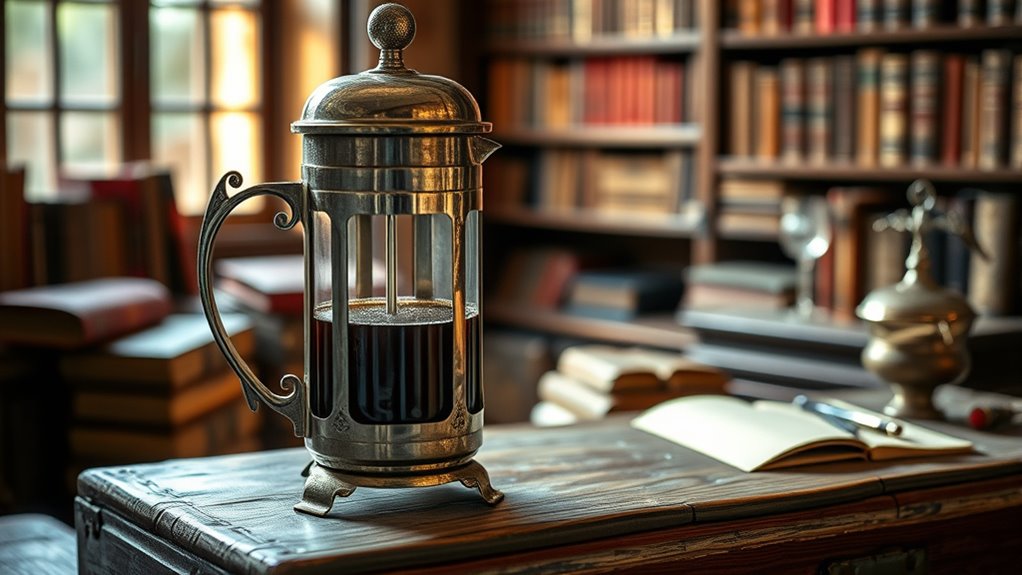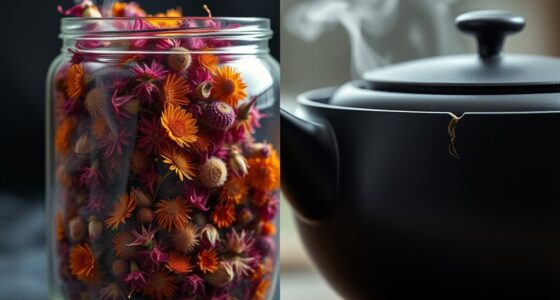The French press has roots in 19th-century France, evolving from early glass and metal designs with a plunger mechanism that improved coffee brewing. Its popularity grew worldwide by the early 20th century, becoming a symbol of fresh, customizable coffee that emphasizes rich flavors. Over time, its simple design fostered a craft-focused approach, connecting enthusiasts to traditional techniques. If you explore further, you’ll discover how it transformed from Chambord’s origins to today’s beloved brewing staple.
Key Takeaways
- The French press originated in France during the 1850s, evolving from early glass and metal designs with a plunger mechanism.
- It gained popularity worldwide by the early 20th century, emphasizing quality, freshness, and hands-on brewing techniques.
- The design’s simplicity enhanced coffee flavor by preserving oils and allowing experimentation with steeping time and grind size.
- It became a symbol of artisanal coffee culture, fostering appreciation for craftsmanship and ritual in coffee preparation.
- Today, the French press remains a popular device, celebrated for its rich flavor, versatility, and role in craft coffee movements.

The French press, also known as a press pot or plunger pot, has a rich history that dates back to the 19th century. You might be surprised to learn that this iconic brewing device has played a significant role in shaping coffee culture around the world. Its simple yet effective design revolutionized brewing techniques, allowing you to enjoy a rich, full-bodied cup of coffee with minimal fuss. As you explore the history of the French press, you’ll see how it influenced both home brewing and specialty coffee scenes, emphasizing quality and craftsmanship. The device’s high extraction efficiency contributes to its ability to produce a more flavorful and aromatic coffee compared to other methods. Initially, the French press’s origins are somewhat debated, but it is generally believed to have been developed in France in the 1850s. Early versions were made of glass and metal, featuring a plunger mechanism that separated the coffee grounds from the liquid. Over time, improvements were made, making the device more durable and user-friendly. By the early 20th century, the French press began gaining popularity beyond France, especially as coffee drinking became a global phenomenon. This innovation allowed enthusiasts and baristas alike to refine brewing techniques, extracting more flavor and aroma from coffee beans than traditional methods like percolators or drip machines.
The rise of the French press coincided with a broader shift in coffee culture, emphasizing quality, freshness, and a more hands-on approach to brewing. You’ve probably noticed how this device encourages you to be more involved in the process—measuring, steeping, and plunging—turning coffee making into a ritual rather than just a routine. Its popularity soared in the mid-20th century, especially among coffee aficionados seeking a more nuanced and customizable experience. The French press’s ability to preserve essential oils and avoid paper filters means you get a richer, more complex flavor profile, which is a hallmark of refined brewing techniques.
Today, the French press remains a staple in both home kitchens and specialty cafes. Its influence on coffee culture is undeniable, fostering appreciation for brewing as an art form rather than a mere necessity. Whether you’re making coffee for yourself or entertaining guests, this device encourages experimentation—adjusting steeping time or coffee grind size—to perfect your cup. As coffee culture continues to evolve, the French press endures as a symbol of authenticity, craftsmanship, and connection to the roots of coffee brewing techniques. Its enduring popularity proves that, with a bit of effort, you can craft a delicious, artisanal coffee experience right in your own kitchen.
Frequently Asked Questions
What Materials Are Traditionally Used in French Press Manufacturing?
You’ll find that traditional French presses are made from durable materials like glass, stainless steel, and plastic. These materials are chosen for their material durability and ease of cleaning. During manufacturing processes, glass is often tempered for strength, while stainless steel is crafted through precise welding and polishing. This combination guarantees the French press remains sturdy, functional, and stylish, making it a reliable choice for coffee lovers like you.
How Does the French Press Impact Coffee Flavor Compared to Other Brewing Methods?
Think of your French press as a painter’s brush, revealing vibrant coffee flavors others might miss. You get fuller coffee extraction, allowing richer oils and aromas to bloom. This method enhances your coffee’s depth, compared to drip or espresso, which can strip away delicate nuances. By steeping grounds directly in water, you emancipate a more robust, nuanced flavor profile that truly showcases your beans’ character.
Are There Any Notable Variations of the French Press Worldwide?
You’ll find notable variations of the French press worldwide, showcasing regional adaptations and cultural variations. For example, in Italy, some add a touch of espresso-style brewing, while in Asia, you might use different types of tea or herbs. These adaptations reflect local tastes and traditions, allowing you to explore unique flavors and brewing styles, making the French press a versatile tool that embraces global culinary diversity.
What Are the Environmental Benefits of Using a French Press?
Think of your French press as a green garden in your kitchen. It offers environmental benefits by using recyclable materials, reducing waste. Its energy efficiency means you don’t need fancy gadgets or electricity, just hot water. By choosing a French press, you’re planting seeds for a cleaner planet, cutting down on plastic waste, and saving energy—making each cup a small act of eco-friendly rebellion.
How Has the Design of the French Press Evolved Over the Centuries?
You’ll notice that the design of the French press has evolved with innovative features, making it more user-friendly. Modern models often include ergonomic handles for comfortable pouring and improved seals to prevent spills. Some incorporate sleek, contemporary materials, and others feature enhanced filtration systems. These updates aim to improve brewing efficiency, ease of use, and aesthetic appeal, ensuring you enjoy a better coffee experience with each press.
Conclusion
As you sip your freshly brewed coffee, it’s wild to think how a simple invention like the French press has traveled from Chambord’s original design to your hands today. That gleaming glass and metal contraption, echoing centuries of innovation, now sits quietly on your kitchen counter. It’s a reminder that history often brews itself unexpectedly—in every pour, you taste not just coffee, but centuries of craftsmanship stirring to life again.









